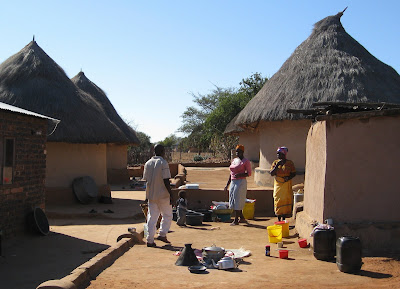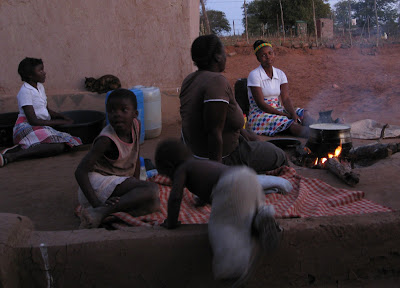 All photos and text by Sally Kneidel, PhD
All photos and text by Sally Kneidel, PhD
Click on pics to enlarge them
We’d already had a fantastic experience, twice, in the Shangaan village of Welverdiend, South Africa. I knew Hamakuya would be different. It’s a different indigenous culture, with a different language. The Venda culture and language of Hamakuya are originally from Zambia, unlike South Africa’s many other indigenous cultures and languages.
We decided to leave the Park via the northernmost gate, the Pafuri Gate, just a couple of miles south of Zambia and Mozambique. As soon as we left the Park, the pavement deteriorated. Women selling one or two fruits of baobab trees stood at intervals alongside the road. Presently the pavement gave way to a “natural” road of dirt and jolting rocks. We had to drive very slowly. Still, it only took about 2 hours from the Pafuri Gate to the little road that leads into the village of Hamakuya. We were in for a treat.
Hamakuya is a very small village, more like a small collection of rural homesteads. They do have a primary school and a food shop, but no other establishments that I saw, and almost no cars. Instead, we saw small donkey carts on the dirt roads, many of them driven by children. Our new friend Thuseni Sigwadi (tshulu@gmail.com), who manages the Tshulu Trust and lives in Hamakuya, met us at the turn-off into the village. Thuseni had arranged for us to do an overnight homestay with the family of Rosina Tshinavhe, a widow with several children.
Rosina has three grown sons who work in Pietersburg, Jo’burg, and the nearby coal mine. Two grown daughters, Sarah and Violet, live with her, as well as a teenage son, Sarani. Sarah and Violet each have a baby, and Rosina has some primary-school children, but there were so many village children on hand to welcome us, I couldn’t tell which ones were Rosina’s. Almost no one except the teenage son Sarani spoke English, or if they did, they kept it to themselves. We did learn a tiny bit of Venda, but not enough to ask about family connections.
Thuseni had arranged for Makuya Fhatuwani to serve as our translator during our homestay. Fhatuwani works with Thuseni, as a nature and bird guide for the Tshulu Trust. Fhatuwani is also training for a job to track poachers for South Africa National Parks. He had a lot to say about that, which will be in a later post.
The Tshulu Trust not only arranges homestays as a way to bolster the income of Hamakuyu families who need it most, but also operates a small nonprofit resort (Tshulu Camp) on the Mutale River, on the outskirts of the village. The Camp features baobab trees, ironwood groves, mopane woodland, and lots of bird species. It attracts birders, students, scientists, and tourists, and is often used for meetings or retreats, employing local people as caterers and housekeepers. More about the camp in a later post.
It so happened that the day we arrived in Hamakuya was a national holiday to honor Hector Pieterson, a martyr of the struggle against apartheid. Holidays mean traditional dancing, which was already underway when we arrived. I didn’t realize at first that it was a holiday; I thought the dancing was all for us! I was a little relieved to find that was not the case. The dancing was different from Welverdiend’s dancing – probably because the main dance troupe was young girls, maybe 8 to 14 years old. They had an incredible amount of energy and danced to drumbeats for a long time, wearing colorful skirts, waving orange scarves in unison, with rattles tied to their lower legs. I was entranced by the dancing.
The leading girl wore a headdress of black bird feathers and blew the dance rhythms on a plastic police whistle. I happened to have a shiny new metal police whistle, which I gave her. She collapsed at my feet when I did (which alarmed me), until I learned that collapse is the Venda way of saying “thank you”.
The homestay was everything we hoped it might be. The buildings of Rosina’s home were lovely. The family lives in several small clustered buildings; most are the single-room round earthen rondavels with thatched roofs that you see all over South Africa.
 Another shot of Rosina’s family compound. Standing are our translator Fhatuwani, Rosina’s daughter Sarah, and Rosina. The cooking pit with kettles and pots is in the center foreground.
Another shot of Rosina’s family compound. Standing are our translator Fhatuwani, Rosina’s daughter Sarah, and Rosina. The cooking pit with kettles and pots is in the center foreground. We slept on homemade mats on the rondavel floor (below), although foam mats are available for homestay guests. Floors were of dried and compacted cow dung and mud, pleasant to the feet and odor-free.
We slept on homemade mats on the rondavel floor (below), although foam mats are available for homestay guests. Floors were of dried and compacted cow dung and mud, pleasant to the feet and odor-free.The cooking area (below) was a small shallow hole in the courtyard, with a tripod over a small fire.
Below, family and friends gather around the cookfire for conversation and food. Rosina’s grown daughter Violet is in the brown shirt.
 Below, one of Rosina’s youngsters washes the family dishes. The cooking pit and its pots are in the foreground.
Below, one of Rosina’s youngsters washes the family dishes. The cooking pit and its pots are in the foreground.

As homestay guests, Ken and I were brought our meals inside our rondavel. Fhatuwani and Sarani often ate with us. First, Sarani poured a gourd of water over our hands to clean them (Ken and Sarani, below).
Below, a mopane worm ready for munching, on a wad of pap in my hand. The worms were surprisingly edible, maybe even tasty. The guts had been squeezed out and they had been dried for storage, then rehydrated with the sauce.

The family’s daily tasks include gathering wood for cooking – which was no big deal in Hamakuya. They have not yet run out of wood as some communities have. Ken and I went with Sarah to collect wood, and we didn’t have to walk far to find the red bush willow they prefer for the cookfire (its smoke smells sweet). With a machete and an axe, she removed enough dead branches from the trees to make a substantial bundle in just a few minutes. Cutting only the dead branches maintains a healthy stock of trees, without depleting the number of living trees and branches.


 Above, Sarah chopped and bundled the wood. She then coiled a towel on top of her head, and carried the bundle home in ten minutes on the top of her head – no hands!! She even doubled over laughing at Sarani’s jokes on the way back, and still didn’t use her hands to steady the bundle!
Above, Sarah chopped and bundled the wood. She then coiled a towel on top of her head, and carried the bundle home in ten minutes on the top of her head – no hands!! She even doubled over laughing at Sarani’s jokes on the way back, and still didn’t use her hands to steady the bundle!
We learned that Rosina, the head of the household, generates income by making and selling brooms and sleeping mats, as well as by hosting homestays.
In addition to the brooms and mats, Rosina’s family also owns a few cattle and chickens, which they can sell if times are tough. Rosina’s sons presumably send her a portion of their income, and I’m guessing the family receives some money from the government for the young children. It’s a meager existence by Western standards. But no less joyful than my own, and in some ways probably more so. The family spends almost all their time outside, almost all their time together, almost always moving around. They cook and eat every meal together, outdoors. That alone might be enough to make me a happy camper. The living quarters, what I saw of it, was impeccably neat and clean. The only bathroom was a “long-drop” (an outhouse) across a rocky field from the house, but that didn’t seem to bother anyone. The only running water was a single spigot shared with other families, 100 meters up the road. That didn’t seem to bother anyone either. They had no electricity. I don’t remember if they had kerosene lamps, I don’t think so. We had flashlights, so wouldn’t have used them anyway. We slept on a grass mat on the cow-dung floor, like everyone else, which was not a problem. I went with Rosina and others to fetch water – she carried several gallons on top of her head (no hands). I couldn’t manage more than a couple of quarts without pain.
I’ve mentioned the good things about their lifestyle, yet I could see that Rosina felt the burden of her responsibility as head of household. Among the daughters and younger children, laughter was plentiful, even though the grown daughters spend much of the day cooking pap, gathering wood, tending the livestock, gathering wild plants to eat, making brooms, taking care of babies. Yet, as a mother myself, I’m sure Rosina worries about health care, secondary schooling for her children, drought, diminishing resources, low wages, difficulty in finding work for all of them. I never saw her at rest; she was always cooking, cleaning, weaving, tending children….working.
Neither Rosina nor the daughters were much inclined to talk to us, even through the interpreter Fhatuwani. Most of what we learned was from Fhatuwani directly or from Rosina’s teenage son Sarani, who attends an internet technology school and is well-acquainted with Western culture. I’m not sure why, but in Welverdiend too we found that the men were much more interested in talking to us than women were (in general, there were exceptions). I would like to understand that better. Do the men go to school longer? Know English better? Do they feel more comfortable discussing the sustainability issues that interested us? Do cultural expectations keep women quiet?
I want to go back, right now. To Hamukuya and to Welverdiend.
But that will have to wait.
If you’re interested in visiting Hamakuya or a stay at Tshulu Camp, as a family or a school group or tour group, you can contact me at sally.kneidel@gmail.com or contact Thuseni Sigwadi at tshulu@gmail.com. Thuseni’s phone is 072 977 6669 within South Africa; from the U.S. it’s 011 27 72 977 6669. If you do go there, you’re supporting a proactive community that very much needs and deserves support. Drought and a rapidly changing world have impacted their lifestyle dramatically. They need a bigger share of the world’s resources, and as Westerners, we can give our travel dollars to them directly, rather than to international hotel chains.
Vha Tshimbila zwavudi (go well, good-bye in Venda)
All photos and text by Sally Kneidel, PhD
Other sources of information on Hamakuya, Tshulu Trust, and Tshulu Camp:
Northwestern University in South Africa blog: Hamakuya and Kruger National Park
A blog post from one of Laurence Kruger’s OTS students who visited Hamakuya
Key words:: Hamakuya Makuya Tshulu Trust Tshulu Camp Venda homestay Africa Kruger National Park cultural village tour South Africa


















